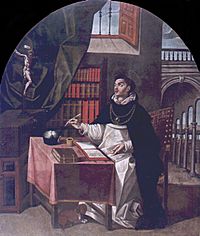Juan de Peñalosa facts for kids
Juan de Peñalosa y Sandoval (born November 7, 1579 – died 1633) was a Spanish artist who painted many religious pictures. He was also a priest and a poet. He is known for his detailed altarpieces, which are artworks placed behind the altar in churches.
About Juan de Peñalosa
Early Life and Learning
Juan de Peñalosa was born in a town called Baena in Spain. His parents were Francisco Peñalosa and Ana Fernandez. He sometimes used his full name, "Peñalosa y Sandoval," perhaps because it sounded more important.
He learned to paint in Córdoba, Andalusia, a city in Spain. His main teacher was a famous painter named Pablo de Céspedes. Juan de Peñalosa also studied and worked with another well-known artist and writer, Francisco Pacheco. Learning from these masters helped him become a skilled painter.
His Famous Paintings
Juan de Peñalosa started signing and dating his artworks after his teacher, Pablo de Céspedes, passed away. One of his first known signed paintings was from 1609. It was a picture of a penitent (someone showing sorrow for their sins) Franciscan friar, which he sent to nuns in Salamanca.
In 1610, he painted a beautiful work called Assumption of the Virgin. This painting shows the Virgin Mary being taken up to heaven. You can see this artwork today in the Museum of Fine Arts in Córdoba. Another important painting is Last Supper, from 1613. This painting shows Jesus's last meal with his disciples. It was made for the Convent of the Holy Martyrs and was a copy of an earlier work by his teacher, Céspedes.
Peñalosa also created paintings for the Santa Barbara Cordoba cathedral. These include pictures of St. Thomas Aquinas and Saint Peter Martyr. He also painted Lady of the Rosary with San Acisclus and Santa Victoria, who are the special patron saints of Córdoba. His paintings often showed rich colors and detailed scenes.
See also
 In Spanish: Juan de Peñalosa para niños
In Spanish: Juan de Peñalosa para niños


